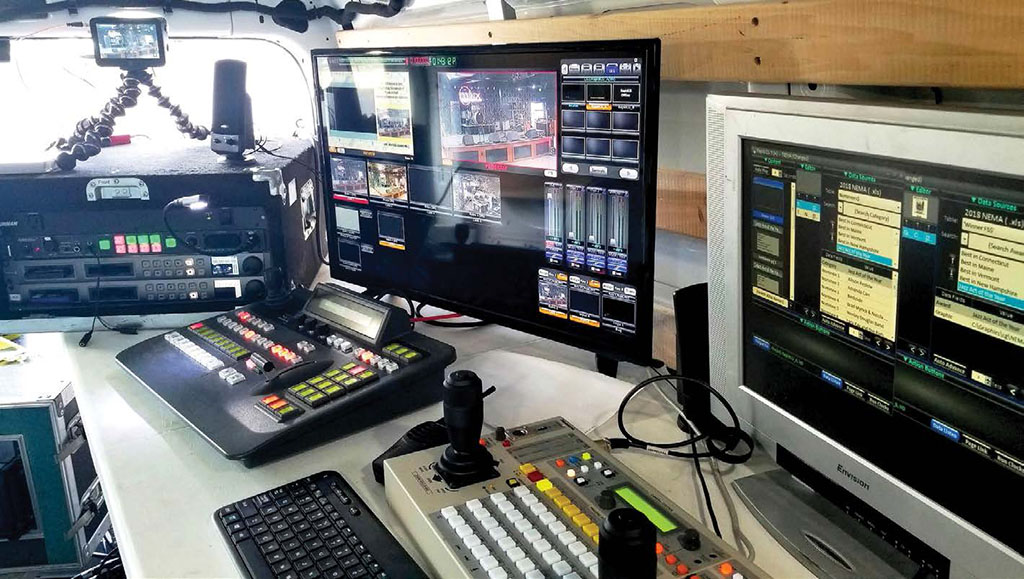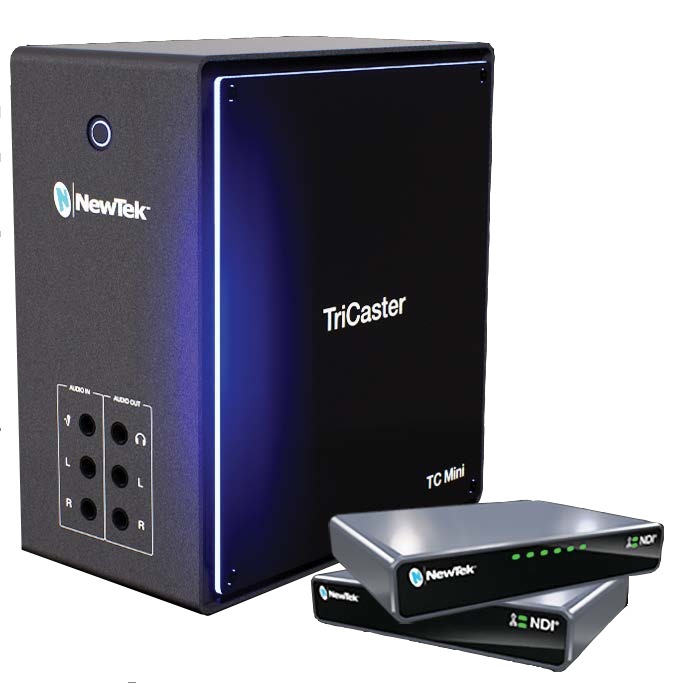Small Package, Powerful Production

ALEXANDRIA, Va.—As a former designer of facilities for creating high-end television productions, I never cease to be amazed by the technological transformation that has overtaken this area of the television ecosystem. Not that long ago, creating such a facility involved much time spent in identifying and purchasing a lot of specialized (and costly) individual pieces of equipment. And once it all arrived, spending more time in mounting and interconnecting the big production switcher, still store, clip store, digital effects unit, outboard keyers, c.g., and monitor wall, and then, likely some additional time in getting everything to play together.
Keeping in line with the now universal trend of “doing more with less,” the creation of good-looking video content has been greatly simplified, moving away from such elaborate and expensive undertakings to small form factor packages with much more affordable price tags, and which can be easily transported right to whatever it is that needs to be televised. And these “teleproduction-centersin-a-box” can be easily driven by a solo operator, rather than the team needed to run the control rooms of yore.
These integrated production systems have become increasingly popular in recent years, enabled by the microprocessor and PC.
“The first integrated production systems became available in the early 2000s, made largely possible by the increase in performance of computers,” said Graham Sharp, chief executive officer of Broadcast Pix in Chelmsford, Mass. “Post-production solutions [had] moved to software running on off-the-shelf computer hardware 10 years before, which was possible because they could operate in non-real time.”
It took a little longer for video processing time to reach a point acceptable for live production.
“As computer power has increased over the last 15 years following Moore’s law, so the performance of [the] IPS has also increased in terms of resolutions and functionality—remember, there was always a minimum [requirement] of producing a video output in real time,” he said.
Rush Beesley, president and founder of RUSHWORKS, a company that’s been providing IPS since 2001, agreed that these Lilliputian production packages owe their existence to today’s supercharged processor and memory chips.
The professional video industry's #1 source for news, trends and product and tech information. Sign up below.
“The dramatic rise in CPU capability, accompanied by the inverse drop in cost for RAM and storage media, have provided the power, speed and reliability for these systems to flourish,” he said.
DEMOCRATIZING VIDEO PRODUCTION
Just as in many other areas, computer technology and IP connectivity have now made it possible for small groups or even individuals to do what once took large buildings, highly skilled teams and large amounts of money to accomplish. The IPS certainly shines brightly here, with these compact, very powerful and feature-laden, video production units allowing production of content virtually indistinguishable from that rolled out by large crews in mega-million-dollar facilities.
It’s also brought affordable broadcast-quality production to markets beyond broadcast as well.
“There is an increasing number of people in educational, corporate, government and religious organizations driven by the constant use of video on social media and mobile devices that want to add video to their storytelling capabilities,” said Matt Allard, product marketing manager of the Vizrt Group, which last year acquired NewTek, another IPS provider. “There are integrated production systems also being used in middle schools. These organizations normally do not have the budget or expertise to implement multiple production components.”
Damon Hawkins, product manager at Grass Valley, whose STRATUS platform places a number of sophisticated production tools in a single application, also observed that such technology is making high-quality video production capability more universal.
“Once reserved for broadcasters and media organizations, professionally produced and packaged content is now leveraged by an ever-more diverse range of organizations as they use compelling storytelling and stunning images to engage their target audience,” he said. “We are seeing an increasing demand from sporting venues, educational institutions, and houses of worship looking for solutions that provide an easy to produce and deliver video content to their consumers.”
WHAT TO LOOK FOR

IPS capabilities have come a long way since the first such units started shipping. (Allard reflected on the great-granddaddy of them, NewTek’s 1990 “Video Toaster,” which later evolved into the company’s “TriCaster.”) He noted that systems now can have as many inputs as large traditional production switchers, allow management of up to eight cameras, and integrate into an IP-based environment through NDI (Network Device Interface) software.
Allard observed that today’s IPS offerings range from “bare-bones” video/audio switching with simple transitions and static graphics, to “extremely comprehensive systems that include IP integration, format flexibility to UHD, multisource video/audio mixing, live streaming output, social media integration, Skype video calling, recording, clip players, replay, chromakeying, virtual sets, automation and custom control.”
Such a plethora of options could overwhelm a first-time purchaser. RUSHWORK’s Beesley suggested that those new to this arena should make a careful assessment of goals and expectations before they step into the IPS pool.
“A prospective adopter should predefine exactly what they want to accomplish with the system,” he said. “No more and no less. Factors include price, configuration and ease-of-use. Then shop according to those criteria.”
Broadcast Pix’s Sharp added that “as a first-time buyer, I would look for a system that is scalable and future-proof, but easy to use and deploy. A well-architected system should be capable of automating complex tasks easily and logically in the setup phase, enabling the user to produce the show with simple, single button pushes.”
THE SKY IS THE LIMIT
Today’s integrated production systems greatly outpace what was expected (or even possible) when they first appeared, and developers are hard at work to make them even more flexible, easy-to-use and reflective of evolving technologies and consumer trends.
“IPS will follow the trends in the industry in terms of acquisition and distribution formats,” said Broadcast Pix’s Sharp. “Smartphones are, and will continue to become, more prevalent acquisition devices and sources of content, particularly with 5G networking almost upon us. With a correctly architected IPS, these advances should present no problems, as the software is scalable, and the introduction of a new file or streaming format should just require some change in file parameters or perhaps a new codec.”
Sharp said that his company is heavily focused on application and ease of use in its products, with a MIDI control interface set to be unveiled at the 2020 NAB Show.
“It enables us to use any MIDI controller to control our IPS software, and we believe will open the market to many younger operators who are used to the various MIDI controllers available.”
NewTek is also keeping pace with the changing video production landscape, recently taking the wraps off a new TriCaster Mini IPS that features all-NDI IP connectivity. There’s also a new camera app that enables an iOS-based device to become an NDI source via Wi-Fi networking.
RUSHWORK’s Beesley says that his company is also taking advantage of NDI technology in its products, with the development of NDI PTZ camera control, as well as integration of a new RUSHPROMPTER for use in remote production. Both will be shown at the NAB Show.
“We’ll also reveal our revolutionary new object tracking capability based on the latest ‘deep learning’ neural network algorithms for identifying and locking onto objects and following them with our PTZ cameras and dolly,” said. Beesley.
Any way you look at it, with its flexibility and resources and capabilities that seem to increase daily, IPS technology seems destined to play an increasingly major role in producing the vast and varied volume of quality content that consumers are demanding.
James E. O’Neal has more than 50 years of experience in the broadcast arena, serving for nearly 37 years as a television broadcast engineer and, following his retirement from that field in 2005, moving into journalism as technology editor for TV Technology for almost the next decade. He continues to provide content for this publication, as well as sister publication Radio World, and others. He authored the chapter on HF shortwave radio for the 11th Edition of the NAB Engineering Handbook, and serves as contributing editor of the IEEE’s Broadcast Technology publication, and as associate editor of the SMPTE Motion Imaging Journal. He is a SMPTE Life Fellow, and a member of the SBE and Life Senior Member of the IEEE.

